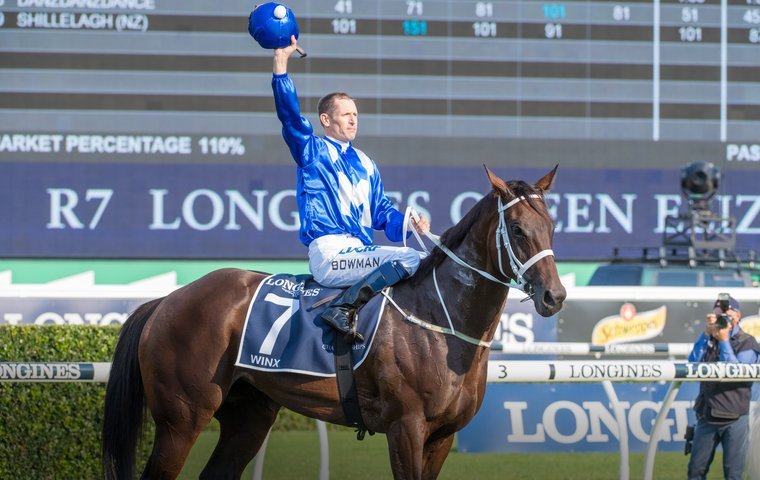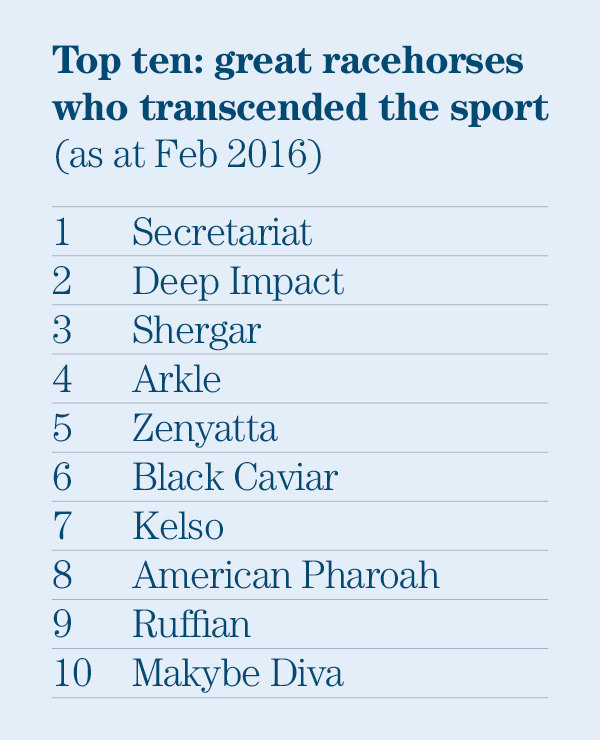
Eight years after compiling his original list of ten horses whose exploits earned renown with the public at large, TRC former editor Chris Smith examines who might now make the cut

 Our original list of great horses who have transcended the sport was first published eight years ago, so of course a big question is: how different would it be if it were being compiled today?
Our original list of great horses who have transcended the sport was first published eight years ago, so of course a big question is: how different would it be if it were being compiled today?
Have any of the magnificent runners to have raced since achieved so much that their names resound beyond the sport of horse racing to the extent that they can be ranked among the elite ten in our list?
(Remember: our original list covered only horses who have raced since the Second World War.)
Great racehorses who transcended the sport: the top five
Ten great racehorses who truly transcended the sport (part one, numbers 10-6)
There are certainly some contenders. Our list was published in February 2016 – 12 months before the awesome Almond Eye began her fillies’ Triple Crown year in Japan.
Two Japan Cups and a Dubai Turf secured her status as the darling of Japan, yet she was never really quite as formidable on the racecourse as her compatriot, the 2023 world champion Equinox.
Unchallenged at the top of Thoroughbred Racing Commentary’s Global Rankings ever since his sensational victory in the Dubai Sheema Classic, Equinox was perhaps the best turf runner worldwide since Frankel and another giant in the land that loves its racehorses with more passion than any other. But did either transcend the sport? The answer has to be no.
A year after Almond Eye was hoovering up the three-year-old distaff silverware in Japan, the US was graced by its second Triple Crown winner in just three years.
Yet Justify failed to find the kind of place in American hearts normally guaranteed for horses who have hit the elusive target that everyone in US racing has constantly in their sights.
What is more, there were some controversies attached to Justify, but perhaps the main reason he was never viewed with the same affection as American Pharoah was the fleeting nature of his racetrack career – just six outings in four months. The public barely had time to get to recognise his name, and we were none the wiser at the end of it as to how good he actually was.
America’s other great contender these past eight years had a similarly short career – again just six runs, although in Flightline’s case they were few and far between as trainer John Sadler nursed him through a spectacular 19-month adventure that had fans and professionals gasping in perpetual admiration and rivals gasping in hopeless, flailing effort as Flightline powered further and further away from them.
Few would argue that he was the best racehorse on the planet in this time, and certainly the best since Frankel, although there isn’t enough evidence to say whether he may have actually been right up there with the likes of Secretariat and Man o’ War as one of the greatest dirt performers the world has ever seen. He just didn’t appear often enough.
Even while the Flightline story was being written, there was an even more remarkable one unfolding Stateside. Cody’s Wish did not possess the same freakish level of ability as Flightline, but he was a flamboyant and hugely talented racehorse – he won back-to-back Breeders’ Cup Dirt Miles after all – and he may ultimately have been at least as popular as the horse he has just succeeded as America’s Horse of the Year.
Cody’s Wish was named after Cody Dorman, a young Kentucky teenager suffering from a cruel genetic disease called Wolf-Hirschhorn syndrome. The wheelchair-bound Cody and the son of Curlin, then a weanling, bonded (the foal laid his head on the boy’s lap) during a visit to Godolphin’s Gainsborough Farm in Kentucky, and were forever connected thereafter.
Americans took both to their hearts, which were tragically broken when the then 17-year-old died the day after the horse’s second Breeders’ Cup win last November.
Cody’s Wish would be very close to our Top Ten, but neither he nor Flightline resonated with the public at large beyond racing enough to supplant any of the names in our original list.
Neither, for that matter, did Europe’s best-loved racehorse over the last eight years – the outstanding Juddmonte mare Enable, dual Arc winner and the first horse ever to follow up success in that great race by winning at the Breeders’ Cup that same season.
And nor do any of the jumpers who have lit up that branch of the sport, so enduringly popular in Britain and Ireland. After all, if the likes of Grand National hero Red Rum and steeplechase legend Desert Orchid did not make the original list, it would be borderline perverse to argue in favour of the likes of Tiger Roll or Honeysuckle – even allowing for the popularity of the winter code.
So none of these mentioned so far make the cut. But one horse does. If the list were being compiled today, there would have to be a place in it for the marvel that was Winx.
The Australian mare was five and had already run 15 times by the time the list was published in February 2016. She had won three G1s, including the 2015 Cox Plate, the most prestigious weight-for-age contest in the Southern Hemisphere, and she had tasted defeat no less than six times.
She was never beaten again, though. Winx was to run 28 times more before her retirement three years later, in the process racking up a 33-race unbeaten run that included a world record 25 G1s.
The daughter of Street Cry (who was also the sire of Zenyatta) went on to win the Cox Plate an unprecedented four times, and most other top Aussie middle-distance G1s at least once (but often two or three times), in the process inspiring a vast travelling fanbase with hundreds donning the Winx silks or special custom-made clothing to illustrate their devotion.
She was No.1 in the TRC Global Rankings for a record 176 weeks, and the world’s all-time highest-earning racehorse until eclipsed just last December by the phenomenal Hong Kong winning machine Golden Sixty, himself almost worthy of consideration here.
Winx never ran outside Australia, but that didn’t stop her popularity spreading across the continents. At the end of 2018, she received votes from fans in 60 countries to become the first non-American runner to win the Secretariat Vox Populi Award, established in 2010 by Secretariat’s owner, Penny Chenery, to recognise “the horse whose popularity and racing excellence best resounded with the American public and gained recognition for Thoroughbred racing”. (Cody’s Wish won the award in both 2022 and 2023.)
Of course, Winx’s longevity and crowd-pleasing come-from-behind surges didn’t hurt, and a year later she was voted World Horse of the Decade by TRC users, beating a shortlist of five completed by American Pharoah, Frankel, Black Caviar and Enable.
The message is clear: if any horse has truly transcended the sport of horse racing since our original list in 2016, it has to be Australia’s Wonder Woman, the wonderful one and only Winx.
What They’re Thinking – Nick Luck: The fan has become the least important part of the puzzle
View the latest TRC Global Rankings for horses / jockeys / trainers / sires


